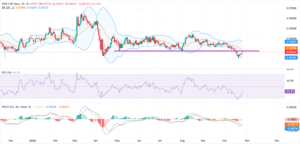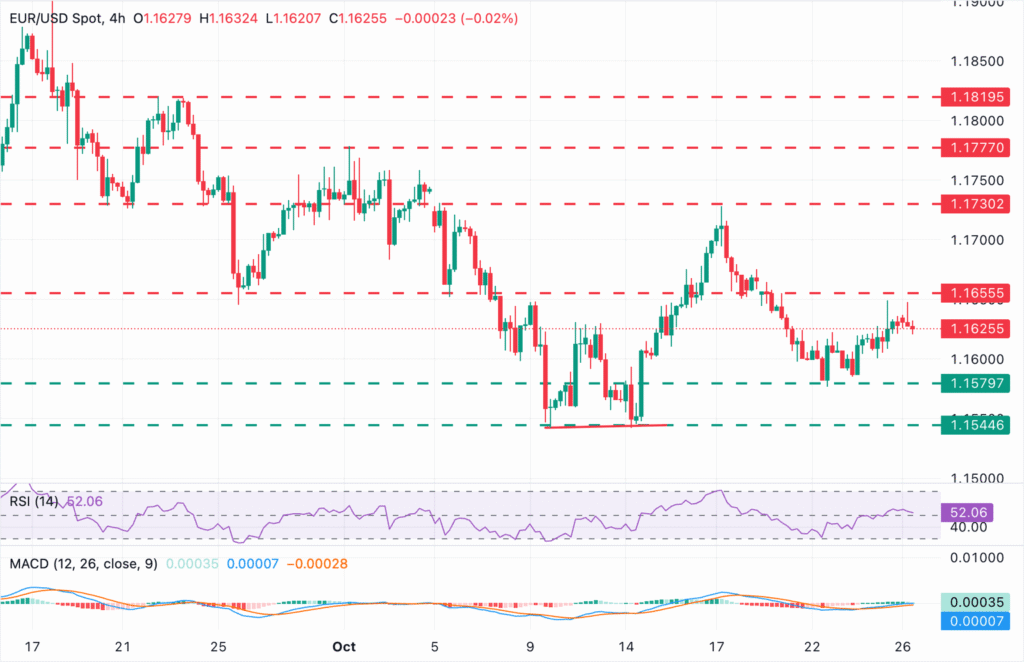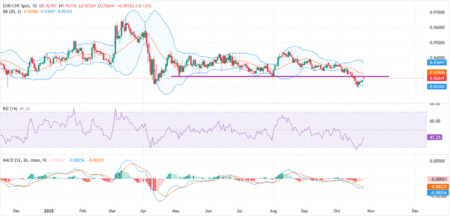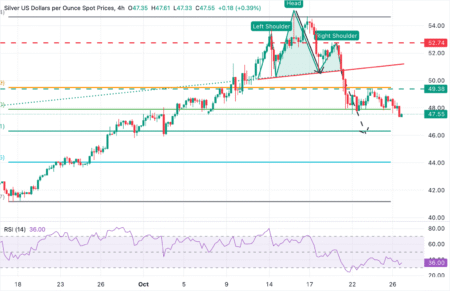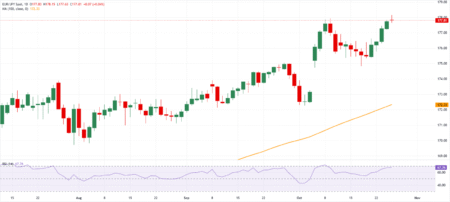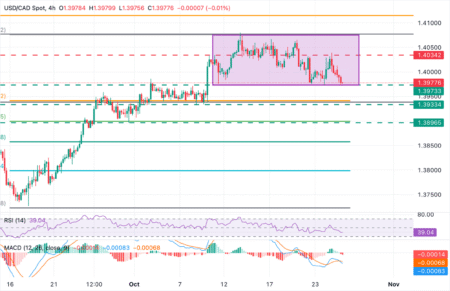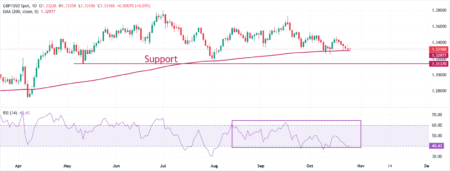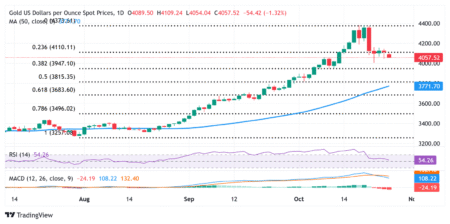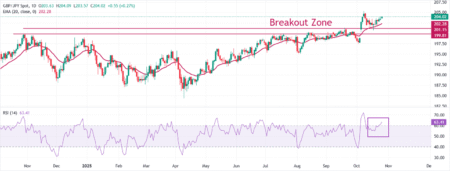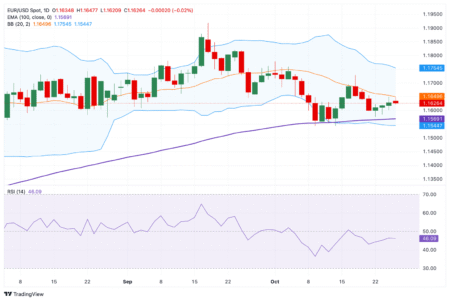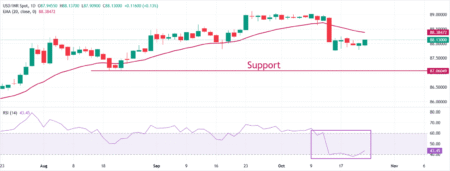EUR/USD is pulling lower from the 1.1650 area, trading at 1.1625 at the time of writing on Monday, yet holding most of the previous days’ gains after bouncing up from 1.1580 lows last week. Market hopes of a trade deal between the US and China have improved investors’ sentiment in an event-packed week, with the Federal Reserve (Fed) and the European Central Bank (ECB) monetary policies in the spotlight.
The positive comments coming from the talks between US and Chinese negotiators in Malaysia this weekend seem to have paved the path for a trade deal at the meeting between US President Donald Trump and his Chinese Counterpart, Xi Jinping, in South Korea, later on the week, that would at least allow for the extension of the trade truce between the world’s major economies.
The economic calendar is thin on Monday, and investors are likely to remain on the sidelines ahead of key events this week. The main focus will be on the outcome of the Fed’s monetary policy meeting, due on Wednesday, but the Eurozone’s Q3 preliminary Gross Domestic Product and the ECB’s monetary policy decision, both on Thursday, might have a significant impact on Euro volatility.
Investors are widely expecting a 25-basis-point interest rate cut by the Fed on Wednesday, especially after the soft US inflation report released last Friday. The main attraction of the event is likely to be the ensuing press conference by the central bank’s Chair Jerome Powell, whose comments will be carefully analysed to assess the chances of another quarter-point cut in December’s meeting.
Euro Price Today
The table below shows the percentage change of Euro (EUR) against listed major currencies today. Euro was the strongest against the Swiss Franc.
| USD | EUR | GBP | JPY | CAD | AUD | NZD | CHF | |
|---|---|---|---|---|---|---|---|---|
| USD | 0.04% | -0.10% | 0.06% | -0.12% | -0.41% | -0.23% | 0.12% | |
| EUR | -0.04% | -0.11% | 0.02% | -0.15% | -0.42% | -0.27% | 0.13% | |
| GBP | 0.10% | 0.11% | 0.14% | -0.03% | -0.30% | -0.16% | 0.23% | |
| JPY | -0.06% | -0.02% | -0.14% | -0.20% | -0.50% | -0.30% | 0.06% | |
| CAD | 0.12% | 0.15% | 0.03% | 0.20% | -0.28% | -0.10% | 0.28% | |
| AUD | 0.41% | 0.42% | 0.30% | 0.50% | 0.28% | 0.15% | 0.54% | |
| NZD | 0.23% | 0.27% | 0.16% | 0.30% | 0.10% | -0.15% | 0.37% | |
| CHF | -0.12% | -0.13% | -0.23% | -0.06% | -0.28% | -0.54% | -0.37% |
The heat map shows percentage changes of major currencies against each other. The base currency is picked from the left column, while the quote currency is picked from the top row. For example, if you pick the Euro from the left column and move along the horizontal line to the US Dollar, the percentage change displayed in the box will represent EUR (base)/USD (quote).
Daily digest market movers: Risk appetite, Fed cut hopes are weighing on the USD
- The Euro remains little moved on Monday but is holding previous days’ gains as the US Dollar remains trading sideways, with rallies limited by investors’ risk appetite due to headlines about the US-China trade negotiations and the expectations that the Fed will ease its monetary policy for the second consecutive time on Wednesday.
- US Treasury Secretary Scott Bessent affirmed on Sunday that US and Chinese representatives have agreed on a positive framework for the Trump-Xi summit later in the week, and suggested that the US president’s 100% tariffs threat is off the table.
- Bessent also affirmed that the Chinese authorities would be open to delaying the restrictions on rare earths trade with the US for one year and to reconsider their position in the meantime.
- On Friday, the delayed US Consumer Prices Index release showed a slower-than-expected inflation with the yearly rate accelerating to 3.0% in September from 2.9% in August, undershooting the market consensus of a 3.1% reading. Furthermore, the core CPI slowed down to a 3.0% yearly growth from 3.1% in the previous month, against market expectations of a steady 3.1% growth.
- These figures have practically confirmed that the Federal Reserve will cut rates by 25 basis points after its two-day monetary policy meeting on Wednesday. The CME Group’s FedWatch tool shows a 6.7% chance of a quarter-point cut this week.
- In the Eurozone, the main attraction on Monday will be the German IFO Business Climate Index, which is expected to show that sentiment remains steady, with a reading of 87.8 in October, following September’s 87.7.
Technical Analysis: EUR/USD keeps treading water within previous ranges
EUR/USD bearish trend from mid-September highs seems to have lost steam. The pair found a bottom around 1.1545 earlier in October and is trying to bounce up from there, but upside momentum remains frail, with investors awaiting key fundamental releases later in the week. This leaves the major currency pair wavering in no-man’s land, between 1.1575 and the 1.1650 area.
Bulls need to breach the 1.1650-1.1660 range (October 21-24 highs) to consolidate the bullish trend and shift the focus to the October 17 high at 1.1728 and the October 1 high near 1.1780. To the downside, a break of the October 22 low near 1.1575 would expose the key support level at the 1.1545 area. Further down, the 1.1500 psychological level seems like a plausible target.
Risk sentiment FAQs
In the world of financial jargon the two widely used terms “risk-on” and “risk off” refer to the level of risk that investors are willing to stomach during the period referenced. In a “risk-on” market, investors are optimistic about the future and more willing to buy risky assets. In a “risk-off” market investors start to ‘play it safe’ because they are worried about the future, and therefore buy less risky assets that are more certain of bringing a return, even if it is relatively modest.
Typically, during periods of “risk-on”, stock markets will rise, most commodities – except Gold – will also gain in value, since they benefit from a positive growth outlook. The currencies of nations that are heavy commodity exporters strengthen because of increased demand, and Cryptocurrencies rise. In a “risk-off” market, Bonds go up – especially major government Bonds – Gold shines, and safe-haven currencies such as the Japanese Yen, Swiss Franc and US Dollar all benefit.
The Australian Dollar (AUD), the Canadian Dollar (CAD), the New Zealand Dollar (NZD) and minor FX like the Ruble (RUB) and the South African Rand (ZAR), all tend to rise in markets that are “risk-on”. This is because the economies of these currencies are heavily reliant on commodity exports for growth, and commodities tend to rise in price during risk-on periods. This is because investors foresee greater demand for raw materials in the future due to heightened economic activity.
The major currencies that tend to rise during periods of “risk-off” are the US Dollar (USD), the Japanese Yen (JPY) and the Swiss Franc (CHF). The US Dollar, because it is the world’s reserve currency, and because in times of crisis investors buy US government debt, which is seen as safe because the largest economy in the world is unlikely to default. The Yen, from increased demand for Japanese government bonds, because a high proportion are held by domestic investors who are unlikely to dump them – even in a crisis. The Swiss Franc, because strict Swiss banking laws offer investors enhanced capital protection.
water within previous
Read the full article here



